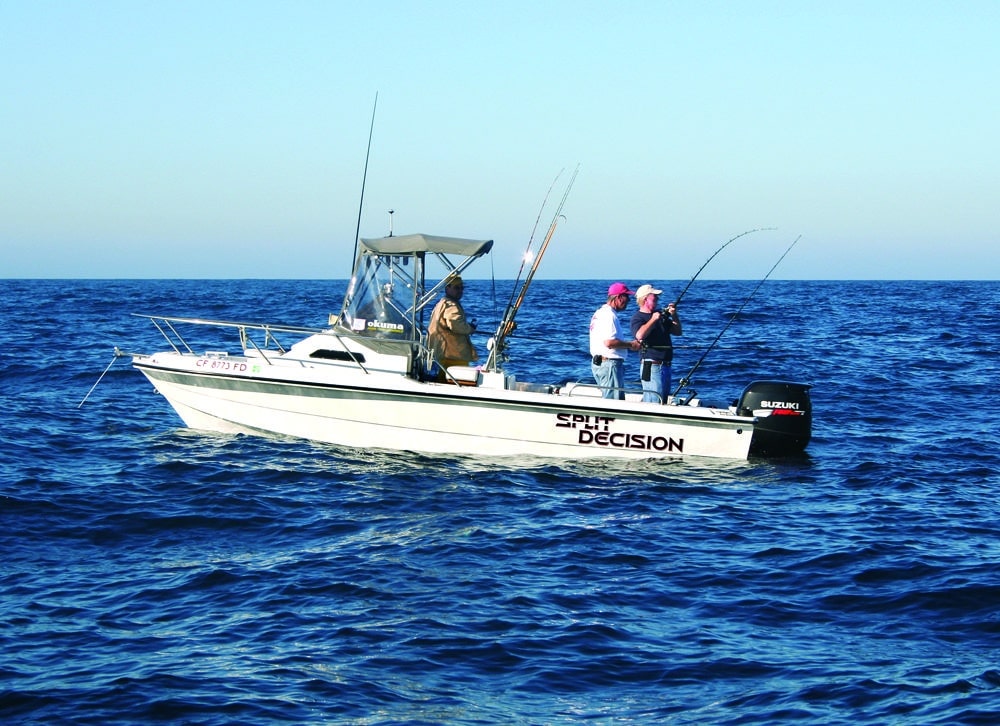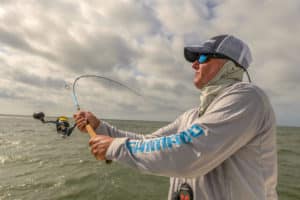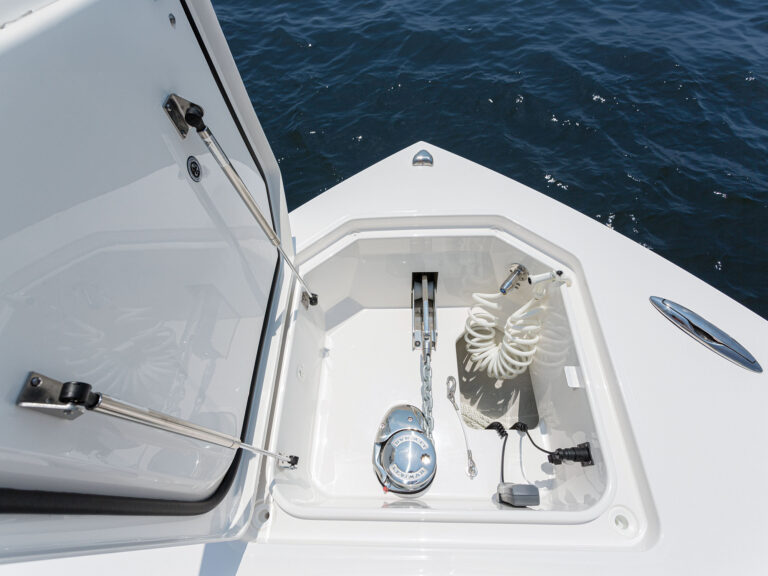
With daytime swordfishing on the rise, anglers trolling multiple lines — some in midwater depths — are also regularly bringing marlin and tuna up from surprisingly deep water. “Until we started fishing buoy rods (baits suspended from floats) near the bottom, we didn’t know we could catch bigeye and yellowfin tunas, mako sharks and blue marlin down 1,200 feet,” says Capt. R.J. Boyle, of Lighthouse Point, Florida. “We didn’t know bluefin tuna bite at 1,800 feet, in 40-degree water.”
Savvy captains extend their spreads vertically, from the bottom up, and experiment with baits for multiple species through the entire water column. Others are looking from the top down, just a bit below the waves to find billfish and tunas when the surface bite slows. I coaxed eight pro skippers to share their deepest secrets for scraping up bites when the surface shuts down, as well as thoughts for targeting billfish and tunas in nearly unfathomable depths.
Going Deep, But Not Too Deep

Midwater buoyed lines are easier to fish than bottom lines. “The lead weight holds the buoy vertical. When fish bite, most swim up, so the buoy just lays over,” says Capt. Lee Green, of Boca Raton, Florida. Some fish pull the buoy underwater instead, but either way, the bite is obvious and fish hook themselves. Hand cranking — Green uses a 50-wide — is also easier. “With a bottom line, you might hook up with 4,000 feet of line out. With a buoy, you’re just driving up to it and reeling in slack. Once you take the buoy off, you have only 500 yards of line to the fish,” he says.
Green’s rig uses heavy braid from his reel to the buoy, and then 1,500 feet of 80-pound Spectra braid connected to his 125-foot wind-on leader. Roughly 8 pounds of lead holds his bait down.
“In the Gulf Stream current, that’s fishing around 1,000 to 1,100 feet deep,” Green says. He also splices in additional buoy-attachment points to fish higher or lower in the water column.
Setting is tricky where the Gulf Stream runs 5 knots to the north near the surface but is nearly slack below 300 feet. Green drops his bottom line first, headed north with the current, and then he sets the buoy line after he turns and drives at 2.5 knots south, which helps to slow his northward troll. To keep the two lines separated, he positions the buoy 100 yards astern and uses one-third more lead and a 50-foot longer leader on the bottom, compared with his buoy line. “In minimal current, say in the canyons, drive into the current and float your buoy off the stern, and then drop your bottom rig,” Green says.
“When you hook up on the buoy line, reel in the bottom rod before you do anything else,” Green says. If the bottom line hooks up first, he starts reeling it in immediately and uses a Hooker detachable electric motor on his 50-wide to retrieve the buoy line unattended. “It reels up so fast, it actually lifts up the bait, with the line at a 45-degree angle, away from the other line.”
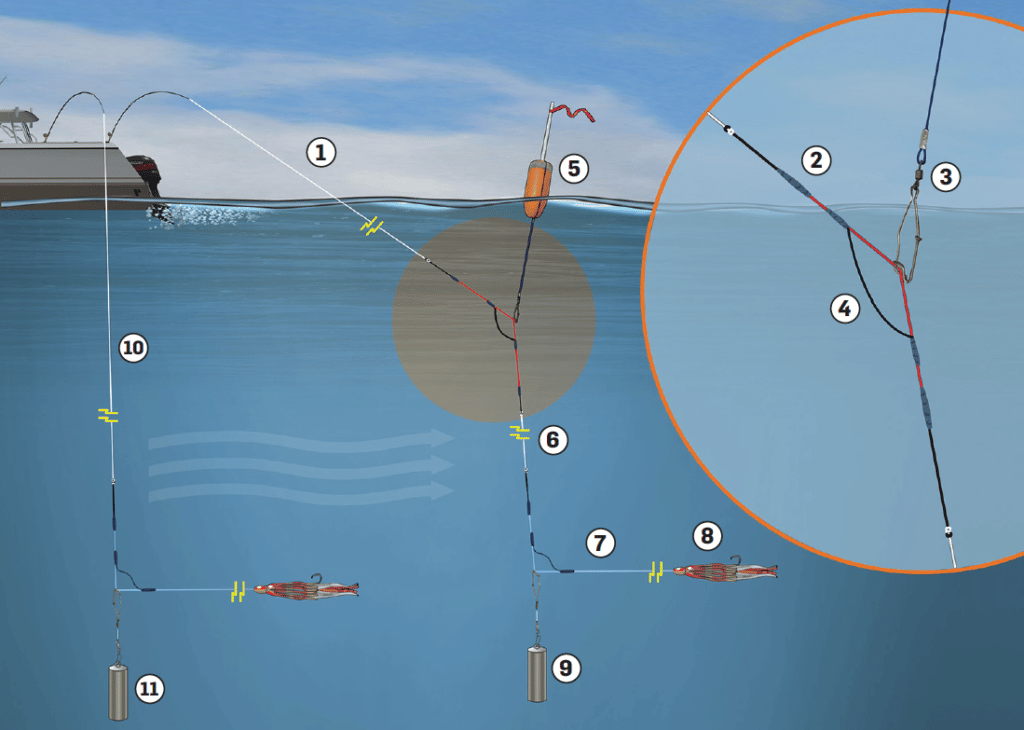
Buoy Rig and Bottom Rod
Capt. Triston Hunt uses the same system as Green in the same waters, rigged on an 80 with all 80-pound braid, but he forgoes the buoy. His second line runs right from the rod tip at the transom instead, letting his lighter lead and shorter leader separate bottom and midwater lines in the Gulf Stream current. “I can control the hook-set. I can drop back. I’m not just leaving it sitting there on a giant bobber,” Hunt says. “If I mark a thermocline at 1,000 feet, I can move that bait there. If I’m getting hit on the bottom rod, I’ll drop the midwater line lower. If I miss a strike on the midwater rod, I’ll reel the bottom line up a bit and get a second chance on that fish.”
To avoid tangles, when Hunt hooks up on the bottom line, he attaches a buoy to his midwater line by wrapping two heavy-duty rubber bands around the braid, and then lets it far astern. “If we hook up on the midwater line, we’ll try to slowly bring in that fish until the bottom line is up.”
Concrete Blocks as Weights, Soda Bottles as Floats

In Venezuela, where deep daytime swordfishing began, Capt. George Sawley often attached a 3-pound concrete weight to a baited hook with 12-pound mono. “We’d drop the bait to the bottom, break off the weight, and wind up about 20 cranks,” Sawley says. A 6- to 8-ounce lead holds the bait down, and a two-liter soda bottle held to Spectra braid with a No. 64 rubber band keeps it afloat. “We’d drop one, then move 100 yards and drop another. I’d put the boat between the two, pass the lines through the long rigger clips, and watch those Coke bottles for a bite.”
Not Quite At The Surface

Wherever schools of tuna and pods of porpoises migrate together, Sawley fishes closer to, although not always at, the surface. “The porpoises use their sonar to find schools of bait. The tunas get in front of them, down deep, and drive that bait up. I’ll gauge when the tunas are coming up by the birds and the porpoises, and just run in and drop my baits. If they’re in when everything is blowing up, it’s a guaranteed hookup.”
When fish become cautious, Sawley instead sets a large planer attached to one transom cleat, which he uses much like a downrigger. “When that deep line goes off, don’t stop the boat. A lot of times you’ll see your long riggers go off,” he says.
Sawley often finds billfish lurking behind the tuna and porpoise melee too. “Any time we are live-baiting in Panama, I put one live tuna, about 4 pounds, on top and another one on a downrigger ball. Probably 70 percent of our fish come on that deep bait,” Sawley says, “usually a mix of blue and black marlin and yellowfin tuna.”
He rigs a 10-pound downrigger ball to 4 feet of cable with a Blacks downrigger clip, which he lowers anywhere from 50 to 120 feet deep from a 130 on a short rod. “On the same side as the downrigger, we troll a ballyhoo or mullet on the long rigger for striped marlin, sailfish, dolphin and tuna.”
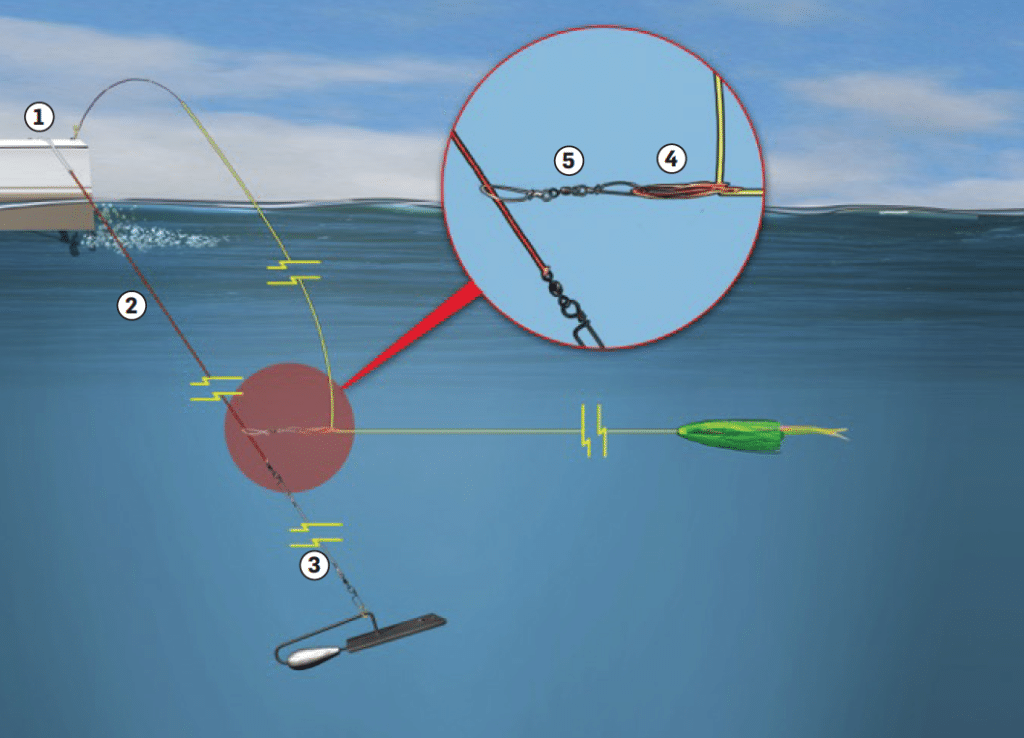
Planer From Cleat
In-line planers have been around for decades, but a removable planer rig is catching on throughout the East Coast. “Some days we mark fish above 20 fathoms, but they just won’t bite the surface spread,” Capt. Chris Gornell, who targets yellowfin tuna off Oregon Inlet, North Carolina. That’s when he gets out a 12/0 senator loaded with heavy braid on a short, stiff rod with wind-on guides, and sinks a trolled bait on a No. 12 planer.
Gornell replaces one flat line with the planer, or he replaces two flat lines by using a smaller planer set farther back on one side, but otherwise his trolling spread and speed don’t change. “Back the drag way off when you get a bite,” he warns.
Other days Gornell uses the same rig with the spoon, but he replaces the planer with a 64-ounce trolling lead. “Troll around at 7 or 8 knots until you mark fish, and then slow down to 3 or 4 knots, take the rod out of the rod holder, and jig it — not fast, but big, long sweeps.”
Midwater Depths for Sailfish
Capt. “Bouncer” Smith often runs a live bait down for sailfish off Miami. “We catch more king mackerel and [false albacore],” Smith says, “but there are days we might hook three or four sailfish on that midwater bait and never see a bite on top, unless it came up with a fish we hooked down deep.”
Smith rigs his midwater line with his standard 13-foot leader plus 10 inches of No. 5 wire. “About 30 feet from the bait, double the line and push it through a 6-ounce egg sinker. Run a piece from a No. 64 rubber band through the loop, so it acts as a stopper,” Smith says. “We fish that the same, between 60 and 80 feet down, whether we’re in 90 feet or 200 feet of water.”

Removable Planer Rig & Spooning
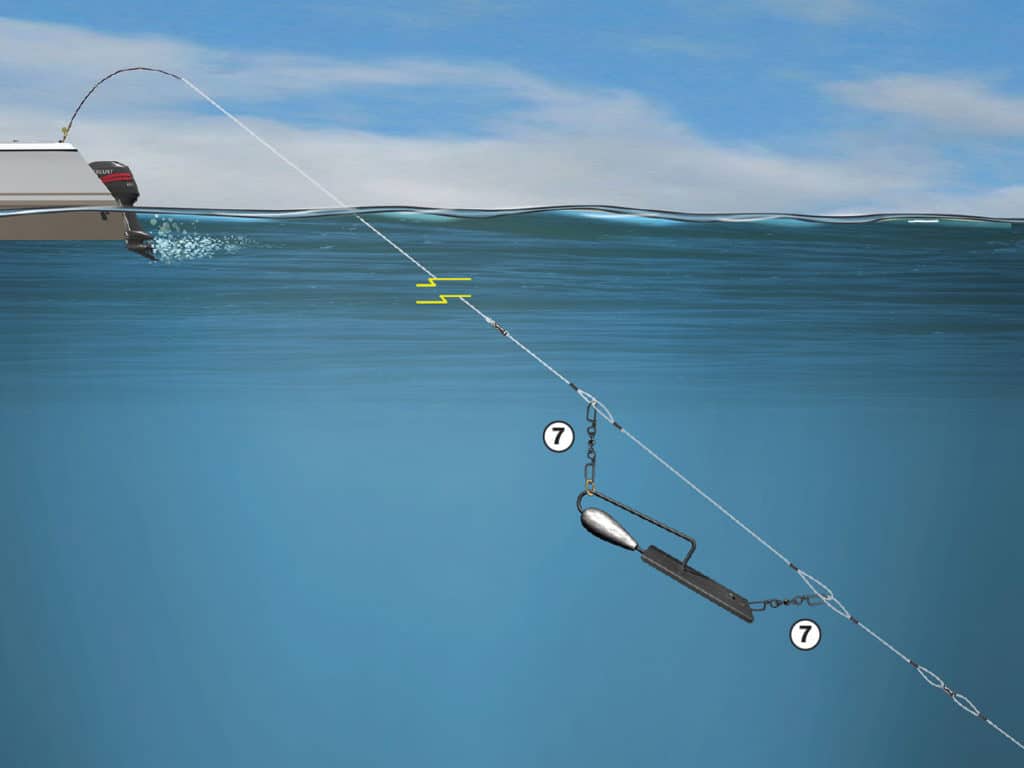
Dredging Up Surface Bites
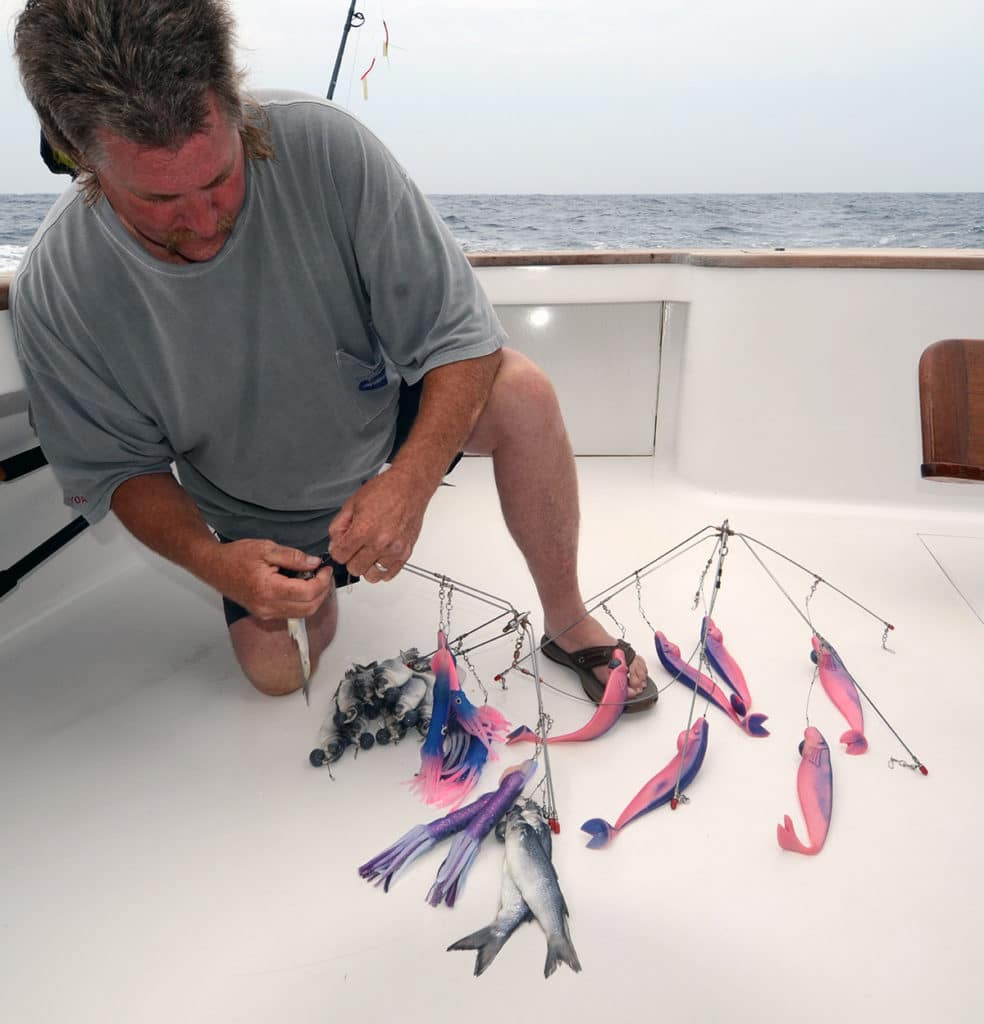
“We have amazing bottom machines now, and we’re marking a lot more fish than we used to,” says Capt. Ronnie Fields. “The deeper fish are less active, but when an easy opportunity comes along, they’re going to feed. I’ll make a tight circle and drop the inside dredge until there’s no more line,” he says, around 100 feet deep. “When it hits the end, I keep turning and reel the dredge back in. Sometimes we’ll see the fish come up with the dredge. Sometimes we don’t see it, but the flat line gets bit,” he says. “Especially for blue marlin, I’ll stay there and stay there, and maybe 30 percent of the time that fish will come up.” Fields also runs one bait long off his center rigger. “When you run over a fish at 200 feet, it takes it a while to get up. That bait way back there is what it sees.”
Off Virginia Beach, Capt. Randy Butler uses live tinker mackerel (Atlantic chub mackerel) to bring white marlin up from below 300 feet. “The mackerel come up to spawn all around the continental shelf when the bottom temperature warms enough,” Butler says, which is usually the first week of July at Norfolk Canyon. “We catch them anywhere from 35 fathoms to 90 fathoms in the corners of the canyons.”
Butler’s mackerel rig has six hooks, each on a 4-inch drop, separated between each drop by 8 inches. Each 4/0 long shank hook gets a piece of bright orange, yellow or green tubing plus a small piece of squid, and a 20-ounce lead pulls it to the bottom. On most days he’s jigging up mackerel just for his surface spread, which he pulls around 4 knots, but if that bite slows, the mackerel rig pulls double duty. “Leave all four baits out, slow to 2 or 3 knots, put the boat in a tight turn, and drop the mackerel rig,” he says. “Marlin follow those racks of mackerel right to the boat. They’re like live-bait dredges. We’re also catching yellowfin, bigeye and big dolphin, and the hammerhead bite is insane.”
How Long Do You Go?

“How many times do we see 10 boats go out and not get a bite for six hours, and then all of a sudden in the seventh hour, everyone hooks up?” Boyle asks. “Are the swordfish there and not eating, or are they somewhere else in the water column?” That question is being answered. “Some days we’ll get only midwater bites on the buoy rod. For some reason — food, temperature, whatever — these fish are staying off the bottom.”
What else are these cutting-edge captains learning from midwater baits? Off South Florida, Boyle says: “Bigeye come mostly on the drop, with about 1,300 feet off the reel. Yellowfin and blue marlin are around that same depth.” Seven giant bluefin tuna caught in 2016 all took swordfish baits on the bottom.
Smith fishes two lines for swords off Miami, similarly to other South Florida buoy techniques, but he changes that up considerably in the Cayman Islands, where seamount tops, typically 1,500 to 1,800 feet deep, are surrounded by as much as 8,000 feet of water. “There is no reason for a swordfish to go to the bottom,” he says.
With less than a knot of current, Smith sets one line on a buoy off the stern with 3 pounds of lead, which stays up around 900 feet deep, where Cayman swordfish seem to lurk. He drops another line directly off the rod tip near the top of the seamount, typically with 5 pounds of lead, and he bump-trolls to maintain 1.5 knots over the bottom.
“When you put the boat in gear, the lines come up, and when you put it in neutral, they sink back down, essentially deep jigging,” Smith says, “to both give baits motion and cover a wider depth range.” “The best opportunity to catch a swordfish is somewhere around 1,500 feet,” Boyle says. This includes the newest emerging fishery in 5,000‑foot depths off Southern California, but like all fishing, there are no guarantees. Boyle fished for two days off Ocean City, Maryland, without a sword bite. “A boat caught a swordfish while live-baiting for marlin in 300 feet. We went to that spot, drew a straight line toward deep water, dropped 1,200 feet, and hooked up. The swords were eating those same tinker mackerel,” he says.
“With situation like that, it’s easy to see to fish a midrange. When it isn’t that clear, that’s when things get difficult. No one wants to get skunked, especially 80 miles offshore,” Boyle continues. “It takes a few industry leaders getting out of their comfort zone, and the guys who are successful have to come clean with that information. That’s how we learn.”
Deep Thinking

“Fish require flow convergences. That’s where the bait is, and that’s where fish will be,” says Dr. Arthur Mariano, a professor at University of Miami’s Rosenstiel School of Marine and Atmospheric Science. That includes not just surface weed lines and current edges, but also stratified depth layers of the ocean.
The deep scattering layer (DSL) is a worldwide congregation of zooplankton, fish larvae, squid and baitfish hovering around 1,500 feet deep during the day. At night, the DSL moves near the surface to feed on sunlight-dependent phytoplankton. “It’s the largest biomass movement on the planet, and it happens every day,” Mariano says.
Satellite tag data shows swordfish accumulate during daylight hours around 1,500 feet, near the DSL, only occasionally diving deeper than 2,500 feet. Tuna seem to forage around 1,500 feet as well. “Those aren’t random vertical movements,” Mariano says. Bait and oxygen intake drive swordfish and tuna.
Marlin prefer warmer water, Mariano says, which is why they’re often within 150 feet of the surface, but Atlantic blue marlin and white marlin might spend a quarter of their day feeding below 150 feet, and they occasional dip below 400 feet, Mariano says. Oxygen levels tend to keep Pacific billfish higher in the water column.
About the Author
Capt. Vincent Daniello, Sport Fishing contributing editor, grew up fishing and diving off South Florida. He ran charters and private boats from Canada through the Caribbean. Now based in Massachusetts, he writes and shoots photos for boating and fishing magazines.
